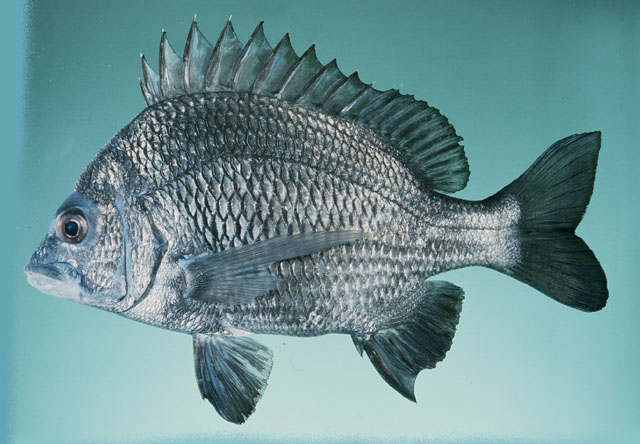
|
Acanthopagrus berda (Fabricius, 1775) Goldsilk seabream |

|
|
photo by
Randall, J.E. |
| Family: | Sparidae (Porgies) | |||
| Max. size: | 90 cm TL (male/unsexed); max.weight: 3,200.0 g; max. reported age: 14 years | |||
| Environment: | demersal; freshwater; brackish; marine; depth range - 50 m, oceanodromous | |||
| Distribution: | Indian Ocean, South Africa, Mozambique, the Red Sea, Persian Gulf, India, Phuket (Andaman Sea, specimen lost), and Malaysia (Penang Island and Langkawi Island, near Singapore). Western Pacific specimens recorded as A. berda refer to Acanthopagrus pacificus (Ref. 86288). | |||
| Diagnosis: |
Dorsal spines (total): 11-12; Dorsal soft rays (total): 10-13; Anal spines: 3-3; Anal soft rays: 8-9. Diagnosis: This species is distinguished from all its congeners by the following characters: scale rows between fifth dorsal-fin spine base and lateral line 3.5; front edge of dorsal scaly area on head slightly convex, with small scales (fewer than 20) anteriorly; pored lateral-line scales 42-44; second anal-fin spine (2AS) longer than third anal-fin spine (3AS), 2AS/3AS ratio 1.23-1.50 (mean 1.36); strongly curved concavity on ventral edge of first two infraorbitals above rear end of maxilla, particularly obvious in specimens more than 13 cm standard length; scales on preopercle flange absent; anal-fin membrane dark; molariform teeth strongly developed along both jaws, teeth rows strongly curved laterally at rear of lower jaw (Ref. 83673). Description: Deep bodied with forked caudal fin (Ref. 52193). Incisors 4-6 in upper jaw, 6-8 in lower jaw (Ref. 52193). Dorsal fin with 11-12 spines and 10-13 soft rays; anal fin with 3 spines and 8-9 soft rays (Ref. 52193). Lateral line scales 43-47 (Ref. 52193). Colouration: Silvery grey to black, with a black patch behind upper gill cover (Ref. 52193). |
|||
| Biology: | Common in estuaries, relatively uncommon in freshwaters (Ref. 52193). It feeds on invertebrates, including worms, mollusks, crustaceans and echinoderms (Ref. 5213), and small fish (Ref. 3670, 52193). Breeds in winter at sea (Ref. 52193). Protandrous hermaphrodite (Ref. 55367). The flesh is excellent; sold fresh in markets. It is parasitised by the monogenean Anoplodiscus australis on the fins and body surface (Ref. 124057). | |||
| IUCN Red List Status: | Least Concern (LC); Date assessed: 28 June 2016 Ref. (130435) | |||
| Threat to humans: | harmless | |||